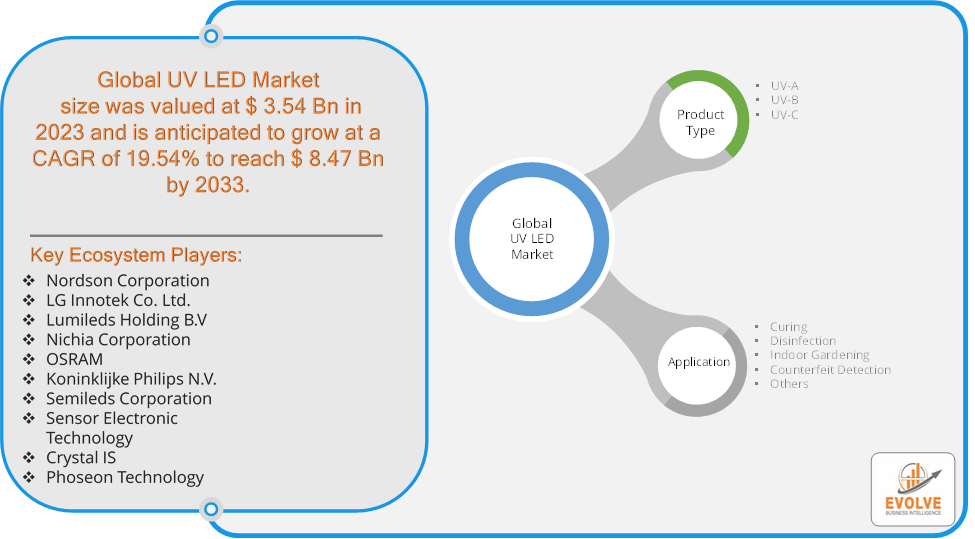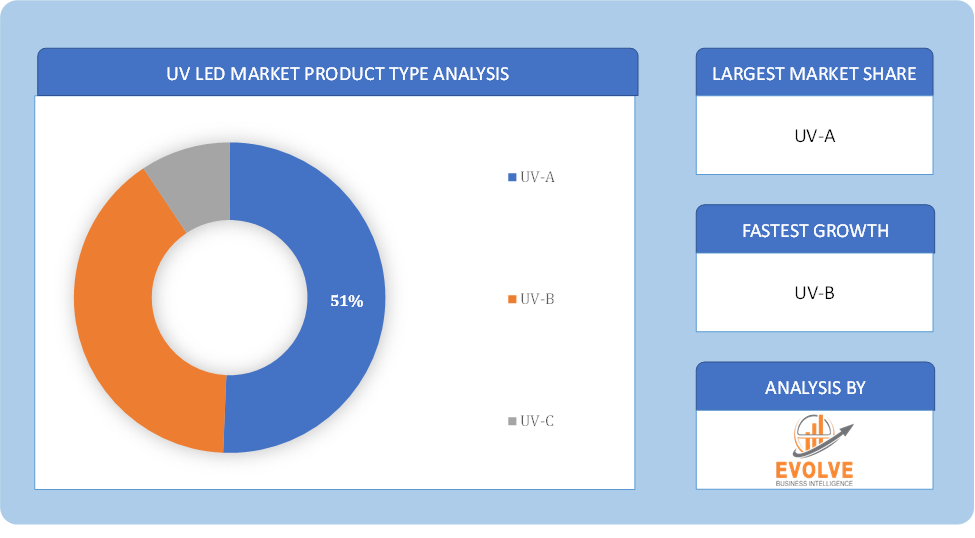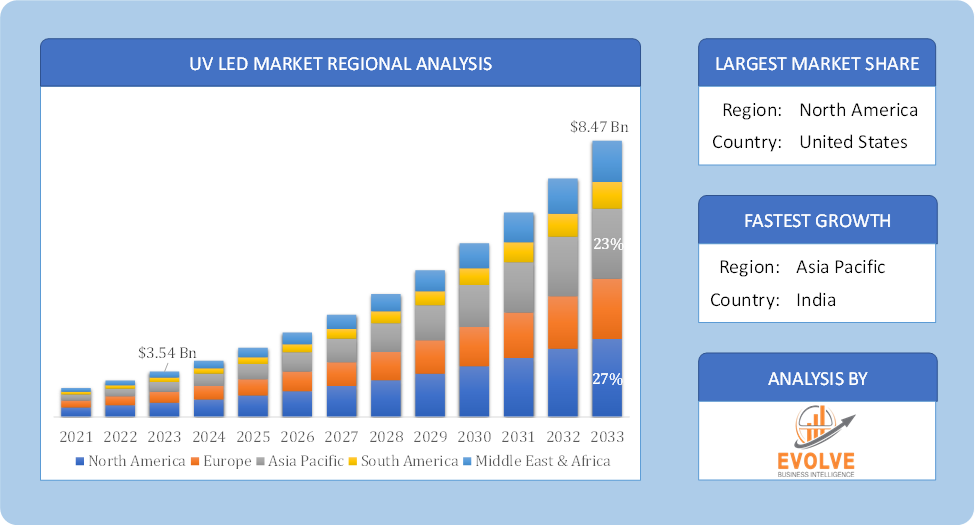UV LED Market Overview
The UV LED Market Size is expected to reach USD 8.47 Billion by 2033. The UV LED Market industry size accounted for USD 3.54 Billion in 2023 and is expected to expand at a compound annual growth rate (CAGR) of 19.54% from 2023 to 2033. The UV LED market encompasses the production, development, and sale of ultraviolet light-emitting diodes (UV LEDs). The UV LED Market refers to the global market for ultraviolet (UV) light-emitting diodes (LEDs), which are semiconductor devices that emit light in the ultraviolet spectrum when an electric current passes through them.
The market is driven by the increasing demand for energy-efficient lighting solutions, the growing adoption of UV-C LEDs for disinfection, and the replacement of traditional mercury-based UV lamps. The UV LED market is segmented by type (UV-A, UV-B, UV-C), application, end-user industry, and geography. Key factors influencing the market include technological advancements, regulatory standards for safety, and environmental concerns related to mercury usage in traditional UV lamps.
Global UV LED Market Synopsis
The COVID-19 pandemic had a significant impact on the UV LED Market. The pandemic led to a heightened focus on hygiene and sanitation, driving an increased demand for UV-C LEDs, which are effective in inactivating viruses, bacteria, and other pathogens. UV-C LED technology was rapidly adopted for disinfecting air, water, and surfaces in public spaces, hospitals, transportation systems, and even households. The need for effective disinfection solutions spurred innovation and the development of new products, such as portable UV-C sterilizers, UV-C robots, and UV-C air purifiers, incorporating UV LEDs. This broadened the market’s application scope. As the pandemic progressed, companies began to mitigate these challenges by diversifying their supply chains, increasing local production, and stockpiling critical components to ensure business continuity. The rapid deployment of UV-C LED products also highlighted the need for clear safety standards and guidelines to prevent improper use and ensure consumer safety. This spurred regulatory bodies and industry players to collaborate on developing and promoting such standards. The pandemic raised global awareness of UV LED technology, leading to increased interest and adoption in regions and industries that were previously less exposed to the technology.
UV LED Market Dynamics
The major factors that have impacted the growth of UV LED Market are as follows:
Drivers:
- Technological Advancements
Ongoing advancements in UV LED technology, such as increased efficiency, higher power outputs, and longer lifespans, drive market growth by making UV LEDs more effective and cost-competitive compared to traditional UV sources. The development of smaller, more versatile UV LEDs enables integration into a wide range of applications, from portable devices to embedded systems, expanding their use in various industries. The rising demand for portable and consumer-friendly disinfection solutions, such as handheld UV-C sterilizers and UV-C sanitizing wands, creates new opportunities for UV LED applications in personal and consumer electronics.
Restraint:
- Perception of High Initial Costs
The manufacturing process for UV LEDs, particularly UV-C LEDs, is more complex and costly compared to traditional UV lamps and even visible-light LEDs. This results in higher initial costs for UV LED products, which can deter price-sensitive consumers and industries. In many emerging markets, the higher cost of UV LED products can be a significant barrier to widespread adoption, especially in applications where cost-effectiveness is a priority.
Opportunity:
⮚ Advanced Sensing and Detection
UV LEDs are increasingly used in specialized sensing and detection applications, such as environmental monitoring, medical diagnostics, and counterfeit detection. The ability to detect specific substances or pathogens with high precision opens new avenues for UV LED integration into critical systems and devices. UV LEDs can be integrated into existing systems, such as water treatment plants, HVAC systems, and manufacturing lines, to enhance efficiency and performance. This retrofit potential offers opportunities for businesses to upgrade their operations without requiring complete overhauls.
UV LED Market Segment Overview
Based on Product Type, the market is segmented based on UV-A, UV-B and UV-C. The UV-C segment dominant the market. Compared to the other two types of ultraviolet (UV) rays, ultraviolet C (UVC) rays have the shortest wavelengths and highest energy levels. UV-industrial C’s applications, like disinfection and sterilization, have enormous future potential due to their wide range of applications. The sun’s UV-C is filtered out by the Earth’s atmosphere. UV-C lighting is a safe and highly effective method of disinfection when it is appropriately designed, installed correctly, and followed safety instructions. UV-C–emitting LEDs comprised of aluminum nitride alloys are significantly more recent.
By Application
Based on Application, the market has been divided into Curing, Disinfection, Indoor Gardening, Counterfeit Detection and Others. The disinfection segment dominant the market. Attributes of this disinfection segment are several, such as increasing demand to keep hygiene properly in the healthcare field as it is more susceptible to spread numerous diseases due to the unhygienic conditions out there and thus, even a healthy person can be prone to infection if they have continuously stayed in such an unhygienic environment.
Global UV LED Market Regional Analysis
Based on region, the global UV LED Market has been divided into North America, Europe, Asia-Pacific, the Middle East & Africa, and Latin America. North America is projected to dominate the use of the UV LED Market followed by the Asia-Pacific and Europe regions.
 UV LED North America Market
UV LED North America Market
North America holds a dominant position in the UV LED Market. North America, particularly the United States and Canada, is a leading region in the UV LED market due to its advanced technology infrastructure and high adoption rates in disinfection and sterilization applications. The region benefits from significant R&D investments and strong demand for UV-C LEDs in healthcare, public spaces, and commercial applications and high initial costs and competition from alternative technologies can be challenging, but these are mitigated by the region’s focus on technological advancements and innovation.
UV LED Asia-Pacific Market
The Asia-Pacific region has indeed emerged as the fastest-growing market for the UV LED Market industry. It’s driven by rising industrialization, urbanization, and increasing awareness of health and hygiene. Key markets include China, Japan, South Korea, and India. The region sees substantial growth in UV LED applications for industrial curing, air and water purification, and consumer products, fueled by economic development and increasing investment in infrastructure.
Competitive Landscape
The global UV LED Market is highly competitive, with numerous players offering a wide range of software solutions. The competitive landscape is characterized by the presence of established companies, as well as emerging startups and niche players. To increase their market position and attract a wide consumer base, the businesses are employing various strategies, such as product launches, and strategic alliances.
Prominent Players:
- Nordson Corporation
- LG Innotek Co. Ltd.
- Lumileds Holding B.V
- Nichia Corporation
- OSRAM
- Koninklijke Philips N.V.
- Semileds Corporation
- Sensor Electronic Technology
- Crystal IS
- Phoseon Technology
Key Development
In June 2023, an international leader in advanced UV-C air and surface disinfection technology, Ultraviolet Devices, Inc., And an association of professionals in infection control made an announcement to introduce an advanced surface sanitizer mainly designed for highly contaminated surfaces that are shared by masses.
In September 2022, Nichia Corporation announced the production of a UV-C LED-based technology with a higher output of 280nm. The company will start mass production of UV-C LEDs with high radiant flux, which helps target the sterilization process and inactivate several bacteria and viruses, particularly for the industrial applications of water and air.
Scope of the Report
Global UV LED Market, by Product Type
- UV-A
- UV-B
- UV-C
Global UV LED Market, by Application
- Curing
- Disinfection
- Indoor Gardening
- Counterfeit Detection
- Others
Global UV LED Market, by Region
- North America
- US
- Canada
- Mexico
- Europe
- UK
- Germany
- France
- Italy
- Spain
- Benelux
- Nordic
- Rest of Europe
- Asia Pacific
- China
- Japan
- South Korea
- Indonesia
- Austalia
- Malaysia
- India
- Rest of Asia Pacific
- South America
- Brazil
- Argentina
- Rest of South America
- Middle East & Africa
- Saudi Arabia
- UAE
- Egypt
- South Africa
- Rest of Middle East & Africa
| Parameters | Indicators |
|---|---|
| Market Size | 2033: USD 8.47 Billion |
| CAGR (2023-2033) | 19.54% |
| Base year | 2022 |
| Forecast Period | 2023-2033 |
| Historical Data | 2021 (2017 to 2020 On Demand) |
| Report Coverage | Revenue Forecast, Competitive Landscape, Growth Factors, and Trends |
| Key Segmentations | Product Type, Application |
| Geographies Covered | North America, Europe, Asia-Pacific, South America, Middle East, Africa |
| Key Vendors | Nordson Corporation, LG Innotek Co. Ltd, Lumileds Holding B.V,Nichia Corporation, OSRAM, Koninklijke Philips N.V, Semileds Corporation, Sensor Electronic Technology, Crystal IS and Phoseon Technology. |
| Key Market Opportunities | · Advanced Sensing and Detection
· Integration with Existing Systems |
| Key Market Drivers | · Technological Advancements
· Consumer Electronics and Personal Devices |
REPORT CONTENT BRIEF:
- High-level analysis of the current and future UV LED Market trends and opportunities
- Detailed analysis of current market drivers, restraining factors, and opportunities in the future
- UV LED Market historical market size for the year 2021, and forecast from 2023 to 2033
- UV LED Market share analysis at each product level
- Competitor analysis with detailed insight into its product segment, Government & Defense strength, and strategies adopted.
- Identifies key strategies adopted including product launches and developments, mergers and acquisitions, joint ventures, collaborations, and partnerships as well as funding taken and investment done, among others.
- To identify and understand the various factors involved in the global UV LED Market affected by the pandemic
- To provide a detailed insight into the major companies operating in the market. The profiling will include the Government & Defense health of the company’s past 2-3 years with segmental and regional revenue breakup, product offering, recent developments, SWOT analysis, and key strategies.









